#games videogames gamedev indiegames gamedevelopment retro pixelart
Explore tagged Tumblr posts
Text
First Person Virus? SpiffyInfo about: Malware Derby (part 1) demo is here
#spiffyinfo#spiffy#game#games#gaming#gamer#videogames#gamedevelopment#gamedesign#indiegame#gamedev#indiegamedev#indiedev#indiegames#retro#fps#deathmatch#zxspectrum#pixel#pixelart#itchio#pc#demo
5 notes
·
View notes
Video
tumblr
Hopping frogs. Doesn’t they look sweet?
#pixelart#indiedev#indiegamedev#indiegame#indiegames#gamedev#gamedevelopment#games#videogames#video games#gamer#gaming#indiegami#gameart#gamedesign#pixel art#8bit#16bit#retro#retrogaming#retrogames#unity3d#madewithunity#gamersunite
13 notes
·
View notes
Photo
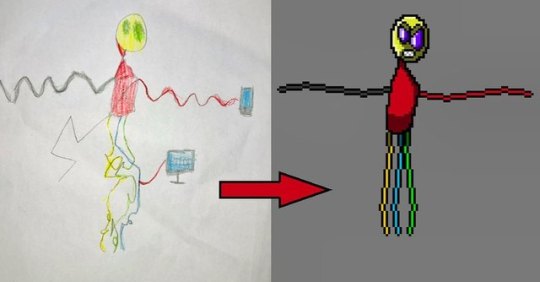
Another one of my sons designs turned to #pixelart ready for his game “KRENNIC”. This is a new boss which evolved from a computer virus! Very cool ideas in that little mind! #gamemaker #gamedev #game #indiedev #indiegame #pixelart #indiegames #gaming #indiegamedev #games #videogame #gamedevelopment #gamer #videogames #GameMaker #gameart #gamedeveloper #gamemakerstudio2 #feedback #indie #retro #Makeagame #VideoGames #Gaming #WorkInProgress #GameDesign https://www.instagram.com/p/BxLVHP4H4TR/?igshid=qyx03hc2vt6a
#pixelart#gamemaker#gamedev#game#indiedev#indiegame#indiegames#gaming#indiegamedev#games#videogame#gamedevelopment#gamer#videogames#gameart#gamedeveloper#gamemakerstudio2#feedback#indie#retro#makeagame#workinprogress#gamedesign
0 notes
Text
Guard Duty: A Development Retrospective - Devblog #5
Ambition versus execution
Today’s post is all about motivation, self discipline and making good use of time. That ever looming presence that weighs on our subconscious, the thing that rudely awakens us each morning. Not the alarm clock! No, the clock is simply a vessel for time, you should never blame the messenger.
For any of you that are following us on social media you will have a much better idea of where we're at with our current build, for those who are not (Go! Go now and follow all things Chicken-y!) I will first bring you up to date.
I can now confidently say that we’ve reached the halfway mark. I would say that somewhere around 60% of the game’s art assets are complete, I’ve still got some of the Northern Region and most of the dystopian future locations to detail *but* the majority of the background scenes for Wrinklewood and the Wildlands are now finished. We’ve been working hard at optimising the gameplay through the first act and a good portion of the second act is now playable too. Andy has put together some really neat puzzle back end stuff, like a Mini-map for one of the dungeon-esque locations and an AI system where a character will follow Tondbert through multiple rooms, losing interest after a set distance if not provoked.
I digress, today’s post is about time management after all.
The most important skill that comes into play when working as an independent game developer is that of self discipline, something that I have never been particularly good at. If there’s anything that this project has taught me it’s that I waste FAR TOO MUCH TIME on Reddit and that simply starting work is often the most important part of making progress. You see, there is this golden window of opportunity where you know you have a certain amount of time available to work and you sit with a project before you (be it a blank photoshop canvas, design document or game client) and you are SO READY to start work that you actually struggle to get stuck into it. It’s those first minutes that can turn into hours of procrastination if you’re not careful. This goes for pretty much every area of life, it’s far too easy to sit around thinking about doing something, rather than actually doing it.
So if I may make a suggestion: If you are sat at your computer, reading this blog post having browsed the web looking for inspiration to work on your own project - press Alt-f4 now! Right now! Ditch Chrome and open AGS, or Unity or whatever and just do something on your project. It doesn’t have to be something huge, just adding a line of dialogue can often lead to another line and before you know it you’ve spent the last hour writing a dialogue conversation you’ve been putting off for days. I often find that it’s these little things that lead to big development sessions that make you late for work the next day (just one more feature before bed!) It’s really important to try and make some sort of progress each day, even if it’s something super simple.
I guess you didn’t hit alt-f4, or you’re reading this on mobile and couldn’t find the function keys. Well, in that case I’ll continue.
Another lesson I’ve learned over the course of developing Guard Duty is one of ambition, that is, not to be too ambitious. I’ll spare you the history lesson (see my first Weblog for that) and skip to the current iteration of Guard Duty. When I started work on the game I was more than a little over ambitious, I had this neat idea revolving around a lovable dysfunctional protagonist who ends up travelling through time in an attempt to put right the wrongs he has caused. A neat concept with an infinite scope for storytelling. Where does he go? Who does he meet? How many time periods? Jeez, it’s a lot of stuff to think about. I put my head down and drafted out the story, planning each significant beat in the story structure whilst trying to envision how the game would play out. It wasn’t long before I realised that the story would have to be a little more grounded, it was far too much work so I decided to go with just one alternate time period rather than several.
I figured I would have the most fun creating two polar opposite ‘worlds’ for the player to explore, one in the old medieval-esque era and one a more futuristic setting, similar to some of my favourite films (Blade Runner, Akira, GitS etc). Admittedly, this took a lot of brainpower to get the initial story draft finished, I was trying to do something new (to me) and pretty ambitious for a video game. It meant that I had to do a LOT of rewriting of the story until I had something that felt coherent, after all I was trying to connect two storylines that were hundreds of years apart.
My shortcoming came when I had finished this draft, I had the story planned out and a rough idea of a few of the puzzles along the way, but this wasn’t anywhere near enough. I went straight ahead and started drawing out backgrounds, designing characters and creating the ‘world’ that the player would experience. Word of advice - don’t do this.
This is the important bit and the best advice I can give anyone looking to take on a large scale adventure game project; Create a rough (very rough) skeleton ‘game’. By this I mean a playable template of your entire game, from start to finish using crappy programmer art. There has been nothing more valuable in GD’s development than this step. By creating the game using mere sketches for backgrounds has allowed me to focus entirely on the story, dialogue and gameplay. You are able to get a feel for how long the game will be, you know exactly how many locations will be in the game and you can get a feel for where you need to add cutscenes, animations and any extra story elements. This also helps immensely for productivity, prior to this step I was getting caught up over trying to get the visual style to a finished quality, taking days or weeks perfecting all the art and animations for single locations (like the town pub, or town square) when I should have been working on getting a playable game together. When you’re using sketchy, half arsed programmer art you no longer worry about these things and can solely focus on getting the game playable, which is a lot more satisfying and feels like you’re making a lot more progress.
Here’s a great example, this is from one of the later sections in the game. It took me an evening to put together and was actually easier to tweak because the rope doesn’t get lost in the background.
youtube
So, don’t be a dummy like me. The ‘skeleton game’ should be your first priority after you’ve decided on the story and overall plot points, it’s a really rewarding process when you can go back and play through last week’s work, feeling like you’ve made substantial progress.
...and on that note I should get back to work! Thanks for reading, ‘til next time.
-Nath
0 notes
Photo

Some of my fav WIPs from the Gameboy game I'm making 😁 #SubterraneanExhibit #subterraneanexhibit #Spikeye #pixelart #pixelartist #pixels #gameboy #GameBoy #GameDev #gamedev #gameboypocket #retro #RetroGaming #indiegame #IndieDev #videogames #videogame #gamedevelopment #gamedeveloper #gbstudio #GBStudio #GBCompo #GBCompo21 #GBCompo2021 #gbcompo #RPG #adventure #ARPG #ChoiceBasedAdventure #characterdevelopment https://www.instagram.com/p/CTc_ab8vJME/?utm_medium=tumblr
#subterraneanexhibit#spikeye#pixelart#pixelartist#pixels#gameboy#gamedev#gameboypocket#retro#retrogaming#indiegame#indiedev#videogames#videogame#gamedevelopment#gamedeveloper#gbstudio#gbcompo#gbcompo21#gbcompo2021#rpg#adventure#arpg#choicebasedadventure#characterdevelopment
1 note
·
View note
Photo

First screenshot of the playable alpha! at last! #indiedev #indiegame #indie #indiegamedev #videogames #pixelart #videogame #pixelgame #pixelartist #arcade #actionrpg #gamedev #retro #screenshotsaturday #retrogaming #gamedeveloper #games #game #gameart #design #gamedevelopment #gamedev #gamedesign #unity3d #indiegamedev #indiegame #unitytips #mobilegamedev #game #developer #indiedevlife
#indie#unitytips#developer#unity3d#gamedesign#games#gamedev#retrogaming#gamedeveloper#videogame#gameart#indiegame#pixelgame#gamedevelopment#game#indiedevlife#design#pixelart#pixelartist#indiegamedev#arcade#indiedev#mobilegamedev#screenshotsaturday#actionrpg#retro#videogames
6 notes
·
View notes
Photo

Artist: ➡️ Drazelic ⬅️ (Find this artist on PixelJoint More pixel art follow @pixelartjonas Game dev & retro bit art @pixelartjonas . . Follow to @Pixelartjonas Follow to @Pixelartjonas Follow to @Pixelartjonas . . . . . . . #pixel #pixelart #pixelartist #8bit #8bitart #aseprite #gamedev #gamedevelopment #indiedev #indiegamedev #gameart #videogameart #gamedesign #indiegame #retrogaming #retrogame #retrogames #gamer #retrogamer #nintendogamer #nin10do #nes #snes #supermario #mariobros #supermariobros #geeky #games #videogames #videogame (hier: Österreich) https://www.instagram.com/p/B5Kx8ukHzj4/?igshid=jqaj7mywxdzc
#pixel#pixelart#pixelartist#8bit#8bitart#aseprite#gamedev#gamedevelopment#indiedev#indiegamedev#gameart#videogameart#gamedesign#indiegame#retrogaming#retrogame#retrogames#gamer#retrogamer#nintendogamer#nin10do#nes#snes#supermario#mariobros#supermariobros#geeky#games#videogames#videogame
0 notes
Text
Revisited the dash/dodge system and added some new SFX. Also added more to the current map, finally starting to bring the city scene together. Next up is a rework of the attack system (This was going to be sooner but I needed to make the dodge changes first) Visit the link in the bio to support me on Patreon and get an exlusive Patron-only wallpaper! More to come!
•
•
•
•
•
•
#yabababagames #alaive #indiegame #indedev #gamedev #gamedevelopment #indedevelopment #videogames #videogame #gaming #gamedesign #pixelart #pixelgame #retro #onpatreon #patreon #developer #design #designer #leveldesign #scifi #programming #gamemaker #entrepreneur #artistsoninstagram #gamingweek #game #games
0 notes
Video
instagram
All the sounds effects are place holders still and some of the graphics/design are likely to change but this is what I’ve been working on all year so far. #indiegame #indiegaming #indiegames #indiegamedev #indiegamedeveloper #gamedev #gamedevelopment #gamedeveloper #gaming #game #videogames #kent #canterbury #ninja #kunoichi #retro #retrogaming #art #digitalart #pixel #pixelart #gameart https://www.instagram.com/p/BxzxyHPnmN8/?igshid=gk8scy2peumu
#indiegame#indiegaming#indiegames#indiegamedev#indiegamedeveloper#gamedev#gamedevelopment#gamedeveloper#gaming#game#videogames#kent#canterbury#ninja#kunoichi#retro#retrogaming#art#digitalart#pixel#pixelart#gameart
0 notes
Text
Could this game have been made in the 80s? SpiffyInfo about: Malware Derby (part 4) demo available on Itch.io here
#spiffyinfo#spiffy#game#games#gaming#gamer#videogames#gamedevelopment#gamedesign#indiegame#gamedev#indiegamedev#indiedev#indiegames#retro#fps#deathmatch#zxspectrum#pixel#pixelart#itchio#pc#demo
0 notes
Text
Keep that car in control! SpiffyInfo about: Malware Derby (part 3) free demo on Itch.io here
#spiffyinfo#spiffy#game#games#gaming#gamer#videogames#gamedevelopment#gamedesign#indiegame#gamedev#indiegamedev#indiedev#indiegames#retro#fps#deathmatch#zxspectrum#pixel#pixelart#itchio#pc#demo
0 notes
Text
Guard Duty: A Development Retrospective - Devblog #4
The Art of Guard Duty - Pixel Practices
Howdy. Today I would like to take some time to talk to you about my process when creating art for Guard Duty. I’m going to be focussing on pixel art and practices you need to be mindful of when creating your art. Hopefully this will give you a bit of an insight into my process for creating the many pixel packed locations in Guard Duty.
Let’s start with a few basic things you’ll need to keep in mind when working with pixels. My advice here is geared around creating pixel art in Photoshop, but most of the rules will apply to other art packages.
First thing’s first - Decide upon a resolution and stick to it.
The problem I see a lot of people run into when starting in pixel art is in consistency of resolution, that is they often mix different resolutions within the image (or game). Mostly called ‘mixed resolution’, it is a where pixels in the image are not all of a consistent size, often leading to an undesirable look. Traditional pixel art is based on the foundation of a grid, where each pixel acts like a grid square. The pixels are unable to be placed outside of these grid squares, therefore keeping a consistency throughout the image. The hardware used to render pixel art in it’s heyday was unable to handle high resolutions, meaning that each pixel had to be carefully placed to make up the intended image.
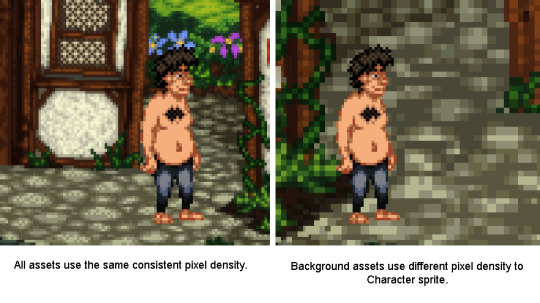
See this graphic for example, the image on the left is using a consistent pixel density whereas the one on the right is using a different density between the character sprite and the background (mixed resolution).
You see the difference? The larger pixels on the right-hand image look messy compared to it’s counterpart, this not only looks a bit strange but does not keep with the traditions of creating pixel art. You want to stick to the resolution you started with. There are some examples of modern games which used mixed resolution pixel art successfully, but these are normally used sparingly and are scaled in-engine, mostly to benefit gameplay.
Platformers often use sub-pixel movement to make gameplay smoother, which can lead to character sprites not lining up correctly with background assets. Sprites however are very rarely scaled in engine as this is far more jarring to look at.
Either way, you will save yourself a lot of hassle if you decide on your game’s resolution at the start and stick to this resolution throughout. Guard Duty uses a similar resolution to many of the early LucasArts and Sierra titles using a 4:3 ratio of 320 x 240px. It might not sound like much but that’s 76,800 pixels you’re going to have to wrangle. More than enough for me!
Moving on - Do not use anti aliased tools
Another problem I see that newcomers often run into is the temptation to use tools designed for high resolution artwork, things like the brush tool, smudge, burn/dodge and gradient fill are all inherently anti-aliased and will give you a heap of extra clean-up work. These tools create way too many pixels, with a massive array of shades and colours. You’ll find that tweaking your artwork becomes increasingly harder when using these tools. So just forget them, resist temptation to smudge your wall texture, or use your neat grass brush, It’s really not worth it if you want to create pixel art. The easiest way to keep track of anti-aliasing is to use (almost exclusively) the pencil tool, the pencil tool can be found by click-holding the brush in the toolbar and selecting the pencil from the drop-down menu.
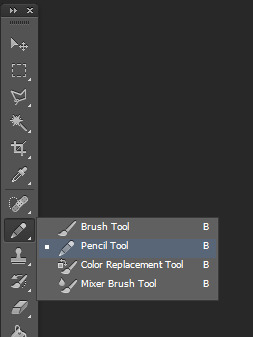
I also recommend turning off the anti-alias setting on the marquee selection tool, transform tool, paint bucket tool and magic wand tool. All of these can be used in pixel art, but with the anti-alias checkbox active you will find that they create a lot of different coloured pixels around the edge of your selection, again causing issues when flood filling areas, or otherwise editing the image.
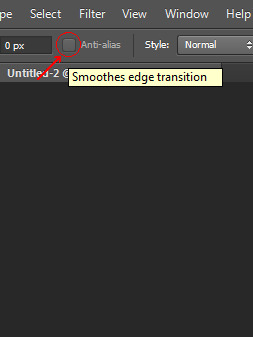
So as a general rule, make sure each pixel that is going onto your canvas is intentional. Photoshop isn’t really geared towards creating pixel art and you want to make sure it doesn’t do anything without your permission. Bad Photoshop! Behave!
Try to avoid scaling your pixel art
This is similar to my first point, but can often catch you off guard. Once you’ve drawn something on the pixel grid you may find that it doesn’t fit in a scene you’ve created previously, despite both images having the same resolution. You’ve drawn the sprite too small and although the pixels are consistently sized, it just looks tiny in the scene. Well, you’re probably going to have to redraw it, somewhat.
When you scale pixel art Photoshop will try to scale the pixels to match the resolution’s pixel grid, anything under a 200% scale will result in only some of the pixels being larger than others (some will become rectangular) and at 200% the pixels will be twice as big, but still fit into the grid. This is because Photoshop has to keep to the bounds of the canvas resolution and doesn’t know what to do with the new space between pixels.
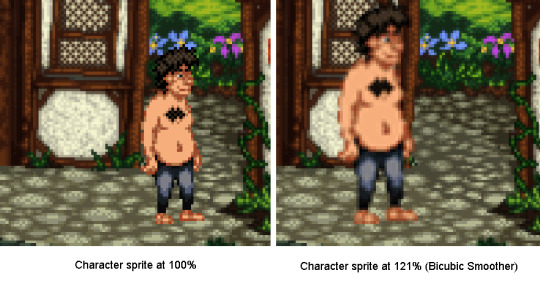
You can see from the image that some of Tondbert’s upscaled pixels have stayed 1px wide/tall whilst others are now 2px wide or tall. His eyes, nose and left shoulder have suffered the most. Poor Tondbert. This is because Photoshop doesn’t know what to do with the pixels, at the chosen scaling it only has ‘small’ (1px) or ‘big’ (2px).
Anyway, to combat these issues you should always draw your pixel art with other assets in mind. When working on a game you don’t want to have to be scaling the character sprites differently between locations, so you should paste your character sprite into the blank canvas for the new location, so you’ve got something to reference the size. If you stick to a consistent resolution with all your art and be mindful of other assets you’re intending to use together you shouldn’t run into any of these problems.
When scaling pixel art, always use Nearest Neighbour interpolation and scale in multiples
Pixel art is kinda small and most modern computers are displaying a 1920x1080 resolution or higher. This means when showing off your pixel art on a website, it can often look reeeeeally tiny. So, you want to be aware of your image resize settings. You need to make sure the image is scaled in exact multiples of itself, 2x bigger 3x bigger etc. So if your canvas is 320 pixels wide and 240 pixels tall, the upscaled image would need to be 640 pixels wide and 480 pixels tall. To keep it simple scale the image to either 200%, 300% or 400% depending on how big you want it, but never 250% or 225%.
There is also a setting at the bottom of the ‘Image size’ box in Photoshop that has a drop down list of interpolation types, next to the ‘Resample Image’ checkbox. Set this to drop down to Nearest Neighbour(preserve hard edges). It will make sure that your pixels always stay crisp when resizing.

There is a similar drop down box when using the transform controls which you will also need to change, if you do not your sprites will become blurred.

Note the amount of pixels Photoshop has added when trying to smooth out the sprite to 121%, this would make the sprite near impossible to modify beyond this point. Using the Nearest Neighbour interpolation solves this issue.
Stick to a limited palette
When starting out with an image I try to keep the colour count to a minimum, this way you won’t get bogged down with tweaking the finer details and can focus on the bigger picture. It also makes tolerance selecting bits of the image a lot easier. Try to keep to three or four colours per texture, dark, mid and highlight colours. You can add extra colours later if needed but removing colours is a bit of a pain.
Now we’ve gone over the basics, let’s get started on a creating a scene.
Start with a basic thumbnail sketch
This technique applies to both sprite and background creation, but for the purpose of this post we’re going to work with a background.
I like to sketch out a few different compositions for the scene before committing to one. I usually find I get something decent by the third sketch but it may take longer, just stick with it. Each sketch shouldn’t take more than a minute or two, we’re just establishing where the shapes in the scene are going to sit. I use a black 1px brush for this stage but the colour is mostly irrelevant (we will be changing that later). I liked the composition in the second sketch and decided to make the opening more central, adding a fallen tree to the left similar to the first sketch.

Develop the thumbnail sketch
I was pretty happy with this so decided to roll with it. The next image shows how I developed the detail in the image, sticking to the sketchy black lines for now. I occasionally use a dark grey colour to show objects that are further back in the frame.

Establish clean 1px outlines
In the next step I set my sketch layer to semi-transparent (20-40%), lock it and create a new layer then begin to outline each of the individual elements. Remember to use a 1px brush and the pencil tool. About 80% of the time I’m holding shift whilst click two points on the canvas to draw a 1px line between the two points. This saves a lot of time and really helps when drawing straight lines, or long curved ones. At this point in the process you want to keep your pixels as clean as possible, avoiding ‘double pixels’ where the line becomes more than 1 pixel wide.
For the time being I’m using a different colour for each of the elements in the scene, this will make it easier to colour them in the next step and helps to cut down on having lots of layers at this early stage. It’s not necessary, but if you’re drawing everything on the same layer I would recommend it. Plus this is probably the only time you’ll get to use bright pink, vomit green and orange in the same scene!

Separate the outlines and block in the colours
Once I’ve outlined the each of the elements in the scene I pick one and start detailing! I don’t worry about the finer details, I just aim to block out the main shapes and colours. What I have done below is use the magic wand tool (anti-alias turned off) with the tolerance set to 0 and contiguous turned off. This way it will select just that colour from the scene. I cut out the element and paste it into a new layer.
I decide upon a highlight colour and start blocking out the parts of the trunk that are raised, drawing these on the same layer as the trunk outline. Underneath on a new layer I am able to fill in the darker base colour of the trunk, as seen in the third image. This leaves the outline and highlights intact and allows me to use a larger brush size to block in the colour underneath.
You can see where I’ve added some trees and foliage from another background in the top right of the image, this is to get a feel for the colours used in those backgrounds, to help consistency between scenes and because I’m too lazy to draw new trees.

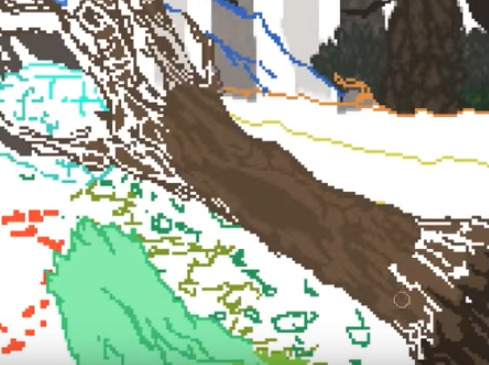
Apologies for the slightly blurry images, they were pulled from the timelapse video.
Add definition with shadows and fine highlights
This is the fun part, giving the object volume. First you want to add another layer above both of your previous layers. Then by carefully placing your shadow colour you can add heaps of definition to the shape. Here I’ve used it to bring out the cracks in the wood, as well as help the branches stand out against whatever will be behind them.

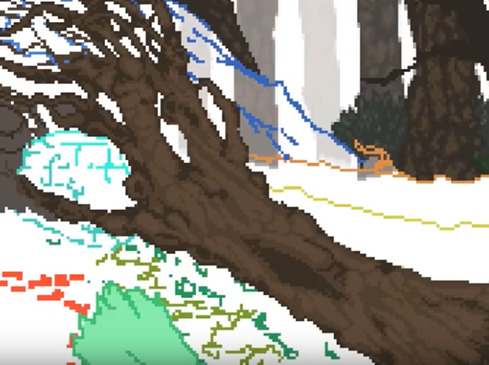
Thanks to having the colours on separate layers I am then able to tweak the balance between the three colours, ready for adding an extra fourth colour for fine highlights.
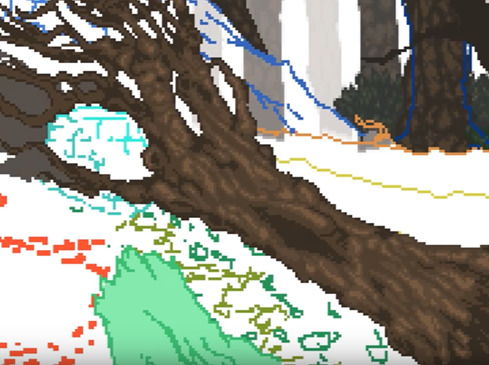
After adding the fourth colour we’re about done, the object has a nice shape to it with a decent amount of detail. You could work on it further from this point, maybe adding a second dark colour for shadows but I tend to leave it here. Remember, every step of this process was done with the pencil tool and a 1px brush, the only exception was the use of a 10 pixel brush for blocking in the colour. You can use this technique for everything in your scene, I like to merge the layers once I’m finished on each object but that’s personal preference. If you do decide to merge them you have the option of using a Brightness/Contrast or Hue/Saturation adjustment layer to tweak the contrast between the highlights and midtones etc, this won’t affect the pixels or add any anti-aliasing.
Okay! That’s about it. There’s nothing particularly fancy going on once you’ve setup Photoshop to handle pixels appropriately, you just need to follow the process I’ve laid out above and you’ll be creating rad pixel art in no time. If you’ve got any questions feel free to drop me a line on one of our social links or email me on the contact form @ www.sickchicken.com.
Here’s the finished image:
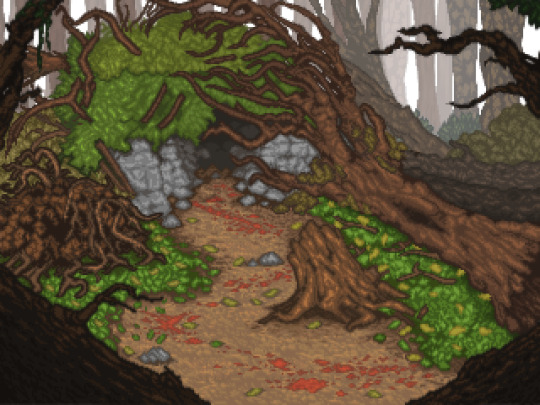
You can watch a timelapse of the process on Youtube here:
youtube
For a bit of additional learning, I highly recommend watching the ‘8bit & 8bit-ish’ Graphics GDC talk by Mark Ferrari:
youtube
Cheers!
-Nath
0 notes
Photo

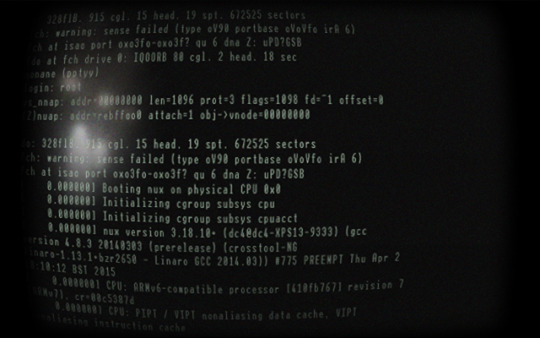
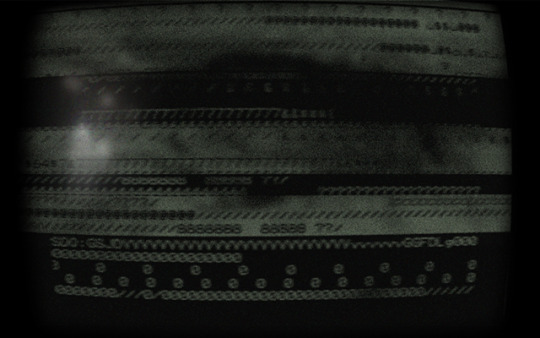
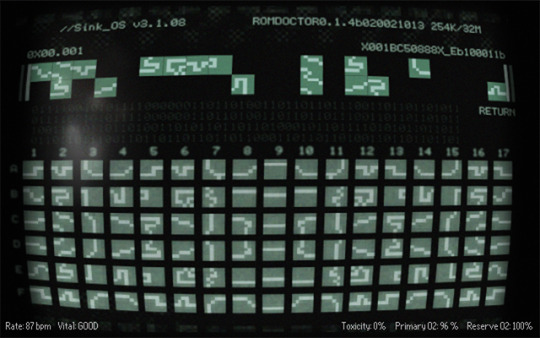
---
Hack your way through complex folder structures in an attempt to bring down a mysterious organisation. Set in a hostile world with limited oxygen, Bitstream features a unique sense of claustrophobia and panic.
Created for the August 2015 MAGS competition by Nathan @ Sick Chicken Featuring Music by Alfonso Gordon and LostTrainDude.
You can download Bitstream at the following link:
https://www.dropbox.com/s/jaqa9w1xnxo48hn/Bitstream.zip?dl=0
Mirror:
https://drive.google.com/file/d/0B79NVQD8PurzU2tUSV8ySi15eFk/view
1 note
·
View note
Text
Guard Duty: A Development Retrospective - Weblog #1
Art direction and the history of Guard Duty
aka 'omg all my other backgrounds look rubbish now, time to redraw them'
--
Howdy! Welcome to the first devlog from us here at Clicknpoint. This one focuses on art direction and the struggles that come with being an aspiring (and unpaid) artist, so on that note i'm going to take the reins.
Hey, i'm Nath (second intro! (⌐■_■) ) I've been working on Guard Duty, on and off since 2003. Yup, tooo long. I was 15 at the time and super excited to release a game with this cool underground game making tool i'd found online (AGS, represent.).
I'd dabbled with a whole bunch of ambitious idea in the years prior to this and my pixel art was at a somewhat presentable level, so I went ahead and started pixelin'. It took a while to land on something I was comfortable with, I'd spent a lot of time trying to nail this simplistic style with only a few colours that still looked really clean and trendy. Mostly because I was obsessed with the AGS game Permanent Daylight by 2ma2, it was a big inspiration to me, kinda like a cheatsheet. I thought to myself 'this is it, this is what I need to make, I need this style of outline, this shading, about six or seven rooms and i'll have an awesome game!'.
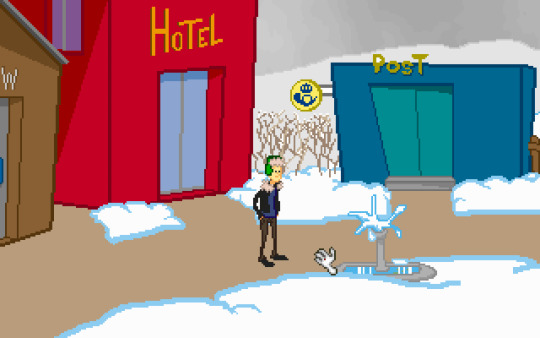
Permanent Daylight by 2ma2 - dem pixels!
I was going to make my own story, setting and puzzles but Permanent Daylight was a really polished game and it showed me that you didn't have to make something super ambitious to make it enjoyable.
That was all well and good, but this is where a pattern of habit started, one I still suffer with today (edgy!). It was about 6 months into trying to make this game 'Guard Duty' that I hit the first hurdle, I had a long street background and a pub,medieval themed and not looking half bad. I'd drawn up a character and iirc, a few of the pub patrons.
I'd started dabbling in swapping pc hardware at the time and somehow managed to kill a Hard Drive, this was at a time where as far as I knew, hard drive data recovery wasn't even allowed outside of the FBI. So I sucked it up and took this opportunity to start fresh on a different project, different name and story - something even more awesome!
That new project lasted a couple of months, but nothing was really working and I already had a story line planned out for Guard Duty.
So it started. I went back to Guard Duty.
Maybe 6 months later and I have 5 or so backgrounds, with three you can walk around and two for an intro.
So I present to thee, Guard Duty V2:
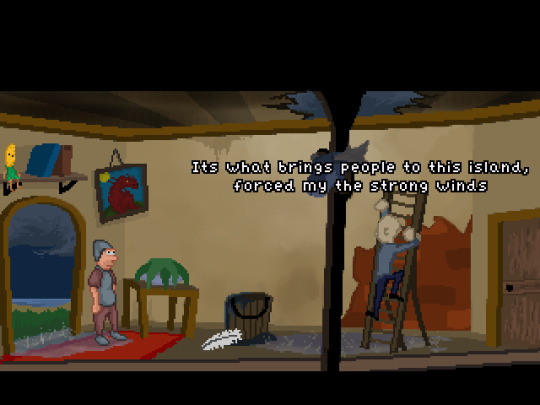
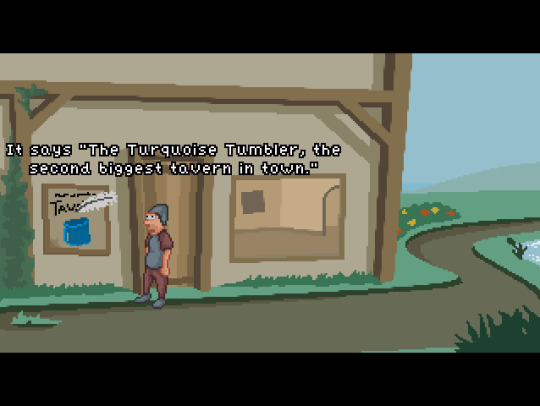
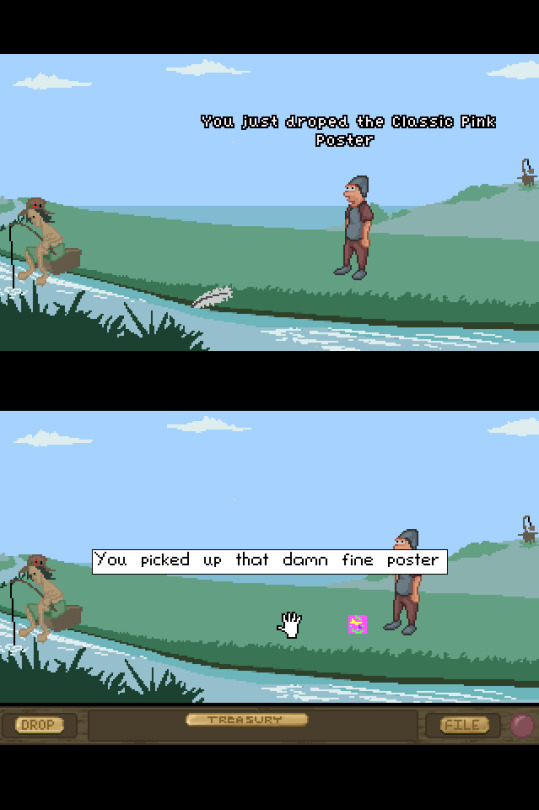
It wasn't half bad, and you could drop items wherever you wanted!
Disclaimer: I'm fairly sure I had a LOT of help getting that to work from the folks on the AGS forums, i'm a terrible coder.
I was happy with the art style and I was pretty well set into making my first game, but alas, things happened in real life and I got a bit distracted.
So time went on, I got drunk a lot, did teenagery things. Then in 2005 I decided that Guard Duty needed to come back! With a BADASS SUBTITLE!
Note: This was a terrible idea. Just, terrible.
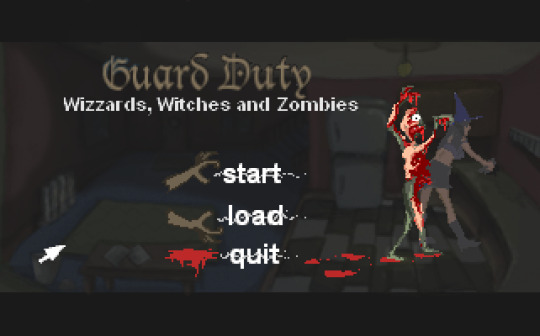
Oh god. Is that a... refrigerator? ...and I’m pretty sure that’s just a hooker wearing a wizard’s hat.
Guard Duty: Wizzards (heh), Witches and Zombies. Yup, totally did the 'add zombies to your game for more bro points' thing before it was a 'thing'.
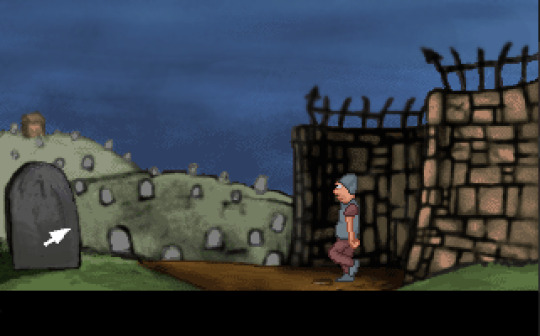
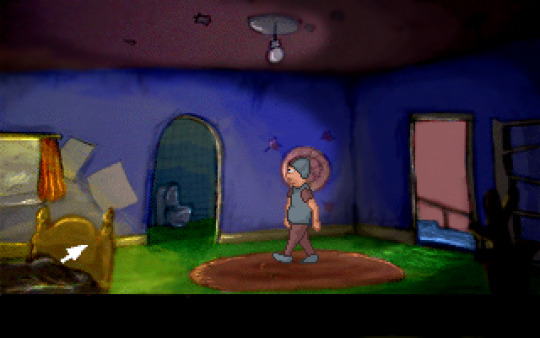
This is pretty embarrassing. It's worse than when they did that HD remake of SoMI.
Discworld: Missing Presumed is one of my favorite adventure games and once I got my hands on a scanner I realised I could do something that 'kinda' looked like Discworld... right?
Not really.
This was also shaming all the work I had put into trying to replicate the clean style seen in Permanent Daylight, so after a few months working on this, again I gave up.
Now you see the habit forming.
For a while I decided Guard Duty was dead, that I wasn't going to revisit the idea ever again. It was cursed or something. I tried working with a team on a few competitions but being an unreliable mid-teenager, I was ambitious but never realistic.
Jump to 2009, King of Pop Michael Jackson dies three days after my birthday and I decide to relapse. That is, revisit Guard Duty! (hurrah!)
I was older now, more edgy. This meant that Guard Duty was too.
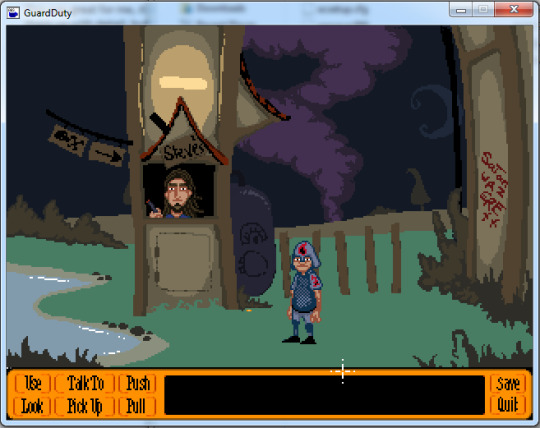
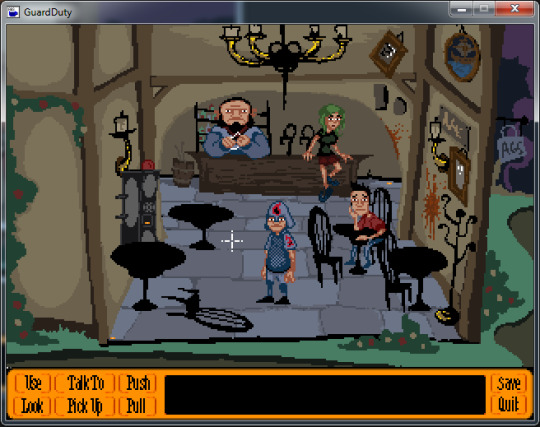
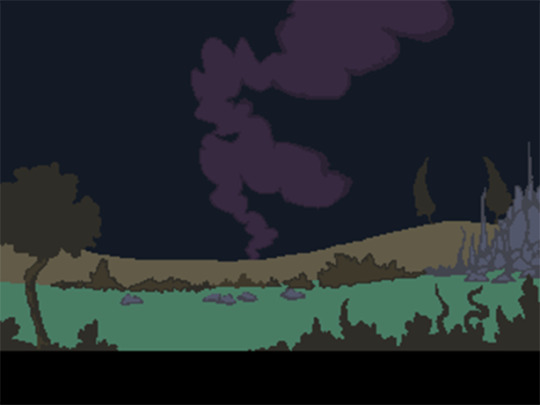
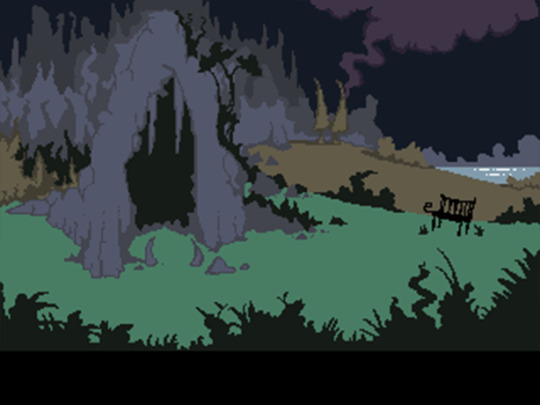
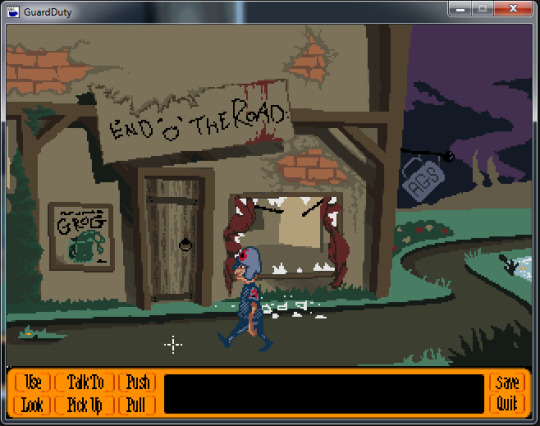
There's an elephant in the room.
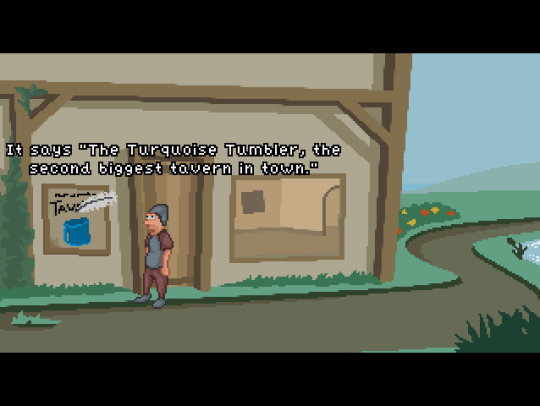
Heh.
This is where I hit a big milestone, I had started to grasp the elements which make up a good composition and I was quickly learning how to implement them.
This was great for me, it meant that I could revisit any of the backgrounds later on and spruce them up with detail, but still being able to continue work on the game. No more restarts, just reworkings. I learnt that if the composition was solid, it didn't matter if the detail was low or messy.
I got to the point where I had about 7 locations with a couple of puzzles and five characters running and playable and I then realised the importance of fabled 'game design document'.
'Pah, I don't need one of them. My game's short, I just need to do the art, then the puzzles and characters will fit right into the world!'
Nope, turns out having a plan for your game -before- making all the art is something you should definitely do. At least, for an adventure game where the puzzles and story are first and foremost.
I'd made a puzzle in the pub because I thought it was cool, but I had no idea how it was going to add to the endgame, I didn't know what the endgame was. So again, I hit a hurdle, struggled with it for a few months and eventually the game went on the backburner.
I took a break from making games, worked on my art skills a bunch and took a liking to film making. It was a LOT quicker to make something go from an idea to a short film. I wen't to uni and studied Digital Arts, and there learnt skills in videography.
I think in the long term, this was the point where I learnt how to stick with a creative project through to the end. I'd made a couple music videos, a handful of short films and written a whole bunch of scripts.
I needed something to sink some time into, I like to keep busy so hey, why not, one last shot.
So with my years of err, wisdom. I decided to try my hardest to do things right this time. I wrote out a design document, decided on key story arcs using a somewhat bastardised version of the 'hero’s journey' (a storytelling technique often used in film making).
After I had a decent enough plan, I started work on the art. Here's where the importance of the initial background composition comes into play. A lot of people use 'programmer art' which is a basic sketch of the layout of the room, normally limited to black and white. This is used so the programmer can continue and implement elements of the game without having the wait for the artist. I find this approach a bit boring, art being my 'thing', so i found a middle ground.
Take this background for example, Tondbert's bedroom.
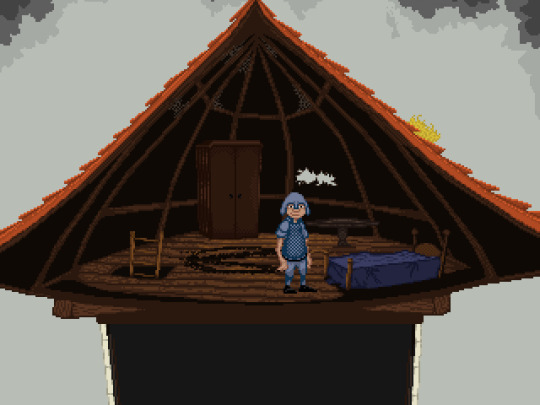
The background initially started as this, just the essentials. It was functional and gave me a good feel for the room.
Now as the game has developed and puzzle elements have come into play the background now looks like this:
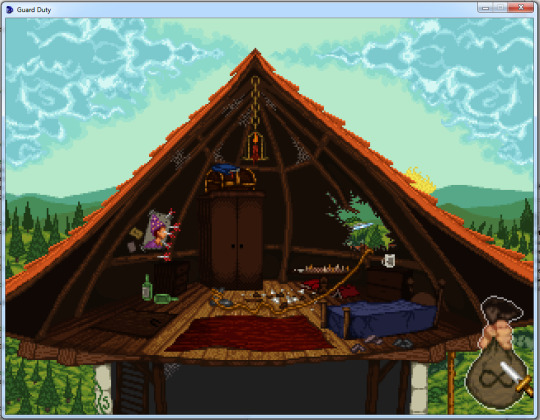
The foundation was there to add all the tiny elements that make up an interesting scene.
It's worth noting that didn’t happen overnight. 3 years have passed between these two screenshots, I've learnt a fair but about colour balance detailing in that time.
After about a year and a half of development (on and off, in my spare time) I decided that the struggle of my ego was over, I suck at programming and someone else could do a much better job and much faster.
It just so happened that I had the perfect man for the job, my good friend and old school (literally) game making buddy, Andy, now lead programmer.
Andy helped a lot by setting up a Trello project board for us to work from (amazing thing that organised people use) it's a pinboard where you can put tasks and add checklists and notes and stuff. We make a card for each room, have a list of the assets needed and a list of all coding tasks.
It's kinda like a race, except you're playing leapfrog.
I make a bunch of sprites, Andy implements them, meanwhile i'm making the next bunch of sprites, Andy is already waiting because he is super fast, Andy implements them. Before you know it, you've completed that card. Fun!
Organised fun!
However, we both work full time, so it takes me ages to get some lists finished, but it's even more rewarding when it happens.
On the plus side, we're independent. Two guys making a game, so we don't really have any time constraints. The game will be released when it's ready, whenever that is :)
So that's it really, a look into how Guard Duty has grown to be the game it is today. We're still a long way off finishing this, but we're both way to deep to turn back now.
Thanks for reading my pixel life story, until next time.
Nath
1 note
·
View note